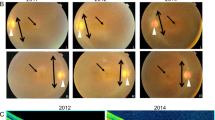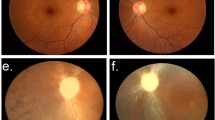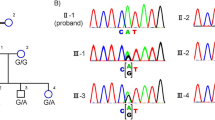Abstract
The RP14 autosomal recessive Retinitis pigmentosa (arRP) locus has been mapped to a 2cM region of chromosome 6p21.3 (refs 1–3). TULP1 (the gene encoding tubby-like protein 1) is a candidate target for the disease mutation because it maps to the RP14 minimum genetic region and because a mutation in the highly homologous mouse tub gene leads to obesity, deafness and early progressive retinal degeneration4–6. Here we report a splice-site mutation (IVS14+1, G→A) that is homozygous in all affected individuals (N = 33) and heterozygous in all obligate carriers (N = 50) from two RP14-1 inked kindreds. The mutation was not observed in 210 unrelated controls. The data indicate that impairment of TULP1 protein function is a rare cause of arRP and that the normal protein plays an essential role in the physiology of the retina.
This is a preview of subscription content, access via your institution
Access options
Subscribe to this journal
Receive 12 print issues and online access
$209.00 per year
only $17.42 per issue
Buy this article
- Purchase on Springer Link
- Instant access to full article PDF
Prices may be subject to local taxes which are calculated during checkout
Similar content being viewed by others
References
Knowles, J.A. et al. Identification of a locus, distinct from RDS-peripherin, for autosomal recessive retinitis pigmentosa on chromosome 6p. Hum. Mol. Genet. 3, 1401–1403 (1994).
Shugart, Y.Y. et al. Fine genetic mapping of a gene for autosomal recessive retinitis pigmentosa on chromosome 6p21. Am. J. Hum. Genet. 57, 499–502 (1995).
Banerjee, P. et al. Homozygosity and physical mapping of the autosomal recessive retinitis pigmentosa locus (RP14) on chromosome 6p21.3. Genomics (in press).
Ohlemiller, K.K. et al. Cochlear and retinal degeneration in the tubby mouse. Neuroreport 6, 845–849 (1995).
Kleyn, P.W. et al. Identification and characterization of the mouse obesity gene tubby: A member of a novel gene family. Cell 85, 281–290 (1996).
Noben-Trauth, K., Naggert, J.K., North, M.A. & Nishina, P.M. A candidate gene for the mouse mutation tubby. Nature 380, 534–538 (1996).
Kumar Singh, R. et al. Exclusion of the involvement of all known retinitis pigmentosa loci in the disease present in a family of Irish origin provides evidence for a sixth autosomal dominant locus (RP8). Hum. Mol. Genet. 2, 875–878 (1993).
Dryja, T.P. & Li, T. Molecular genetics of retinitis pigmentosa. Hum. Mol. Genet. 4, 1739–1743 (1995).
North, M.A., Naggert, J.K., Yan, Y., Noben-Trauth, K. & Nishina, P.M. Molecular characterization of TUB, TULP1, and TULP2, members of the novel tubby gene family and their possible relation to ocular diseases. Proc. Natl. Acad. Sci. USA 94, 3128–3133 (1997).
Hagstrom, S.A., North, M.A., Berson, E.L. & Dryja, T.P. Recessive mutations in the gene encoding the tubby-like protein TULP1 in patients with retinitis pigmentosa. Nature Genet 18 , 174–176 (1998).
Krawczak, M., Reiss, J. & Cooper, D.N. The mutational spectrum of single base-pair substitutions in mRNA splice junctions of human genes: causes and consequences. Hum. Genet. 90, 41–54 (1992).
Jacobson, S.G. et al. Phenotypes of stop codon and splice site rhodopsin mutations causing retinitis pigmentosa. Invest. Ophthalmol. Vis. Sci. 35, 2521–2534 (1994).
Reig, C. et al. New mutation in the 3′-Acceptor splice site of intron 4 in the rhodopsin gene associated with autosomal dominant retinitis pigmentosa in a Basque family. Hum. Mut. 8, 93–94 (1996).
Fujita, R. et al. Analysis of the RPGR gene in 11 pedigrees with the retinitis pigmentosa type 3 genotype: paucity of mutations in the coding region but splice defects in two families. Am. J. Hum. Genet. 61, 571–580 (1997).
Lincoln, A.L., Daly, M. & Lander, E. PRIMER: a computer program for automatically selecting PCR primers. Whitehead Institute Technical Report (1991).
Author information
Authors and Affiliations
Corresponding author
Rights and permissions
About this article
Cite this article
Banerjee, P., Kleyn, P., Knowles, J. et al. TULP1 mutation in two extended Dominican kindreds with autosomal recessive Retinitis pigmentosa. Nat Genet 18, 177–179 (1998). https://doi.org/10.1038/ng0298-177
Received:
Accepted:
Issue Date:
DOI: https://doi.org/10.1038/ng0298-177
This article is cited by
-
Whole-genome and dispersed duplication, including transposed duplication, jointly advance the evolution of TLP genes in seven representative Poaceae lineages
BMC Genomics (2023)
-
Tulp1 deficiency causes early-onset retinal degeneration through affecting ciliogenesis and activating ferroptosis in zebrafish
Cell Death & Disease (2022)
-
Distinct mutations with different inheritance mode caused similar retinal dystrophies in one family: a demonstration of the importance of genetic annotations in complicated pedigrees
Journal of Translational Medicine (2018)
-
Drosophila king tubby (ktub) mediates light-induced rhodopsin endocytosis and retinal degeneration
Journal of Biomedical Science (2012)
-
Overexpression of CaTLP1, a putative transcription factor in chickpea (Cicer arietinum L.), promotes stress tolerance
Plant Molecular Biology (2012)



